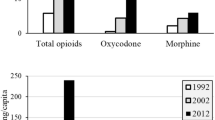Summary
The pharmacokinetics of bendroflumethiazide (BFT) was investigated following the oral administration of 10 mg to 3 healthy volunteers. Each subject participated twice in the study. BFT was determined in plasma and cantharides blister fluid from 1/2 to 30 h post administration. Blister fluid was obtained from blisters 10–22 h old. Plasma levels were fitted to a tri-exponential equation and the concentration of the drug in the peripheral compartment was calculated from the microscopic rate constants. In 5 of 6 cases investigated, cantharides blister fluid levels paralleled the concentration of the drug in the peripheral compartment. The mean blister fluid levels exceeded the calculated concentration in Compartment 2 1.46 fold. In one case, the blister fluid level paralleled the plasma level. This subject clearly differed from the others as more than 10 h were required for blister formation in her. The results suggest that following the administration of BFT, cantharides blister fluid behaves as part of the peripheral compartment. The possible value of studying blister fluid levels in pharmacokinetic investigations is discussed.
Similar content being viewed by others
References
Hinderling PH, Garrett ER (1976) Cited according to: Garrett ER. The pharmacokinetic bases of biological response quantification in toxicology, pharmacology and pharmacodynamics. In: Jucker E (ed) (1977) Progr Drug Res 21: 105–230
Kanto J, Allonen H, Kleimola T, Mäntylä R (1981) Pharmacokinetics of labetalol in healthy volunteers. Int J Clin Pharmacol Ther Toxicol 19: 41–44
Adam D (1979) Tissue concentrations of cephalosporin antibiotics in man. In: van der Waaij D, Verhoef J (eds) New criteria for antimicrobial therapy: Maintenance of digestive tract colonization resistance. Proc. Symp. Utrecht, 1979. Excerpta Medica, Amsterdam, pp 174–184
Simon C (1976) Antibiotikaspiegel in Serum, Speichel, Tränenund Hautblasenflüssigkeit. Infection 4 (Suppl 2): 91–94
Eickenberg H-U, Scharfenberger L, Waterman NG (1976) Concentration of antibiotics in renal interstitial fluid, soft tissue interstitial fluid, urine and serum. Infection 4 (Suppl 2): 97–102
Cadórniga R, Barrios S, Segura J, Roberts DJ (1979) Penetration of antibiotic into tissue fluid following parenteral administration of lysine cephalexin. Arzneim-Forsch 29: 1547–1549
Wise R, Gillett AP, Cadge B, Durham SR, Baker S (1980) The influence of protein binding upon tissue fluid levels of six β-lactam antibiotics. J Infect Dis 142: 77–82
Tight RR, White AC (1980) Serum and subcutaneous chamber fluid dynamics of penicillins after single large parenteral doses. Antimicrob Agents Chemother 17: 229–234
Schäfer-Korting M, Mutschler E (1982) Pharmacokinetics of bendroflumethiazide alone and in combination with propranolol and hydrolazine. Eur J Clin Pharmacol 21: 315–323
von Hattingberg HM, Brockmeier D, Kreuter G (1977) A rotating iterative procedure (RIP) for estimating hybrid constants in multicompartment analysis on desk computers. Eur J Clin Pharmacol 11: 381–388
Brettell HR, Smith JG, Aikawa JK (1964) S35-labeled bendroflumethiazide in human beings. Arch Intern Med 113: 373–377
Garrett ER (1977) The pharmacokinetic bases of biological response quantification in toxicology, pharmacology and pharmacodynamics. Prog Drug Res 21: 105–230
Olcewski WL, Engeset A, Sokolowski J (1977) Lymph flow and protein in the normal male leg during lying, getting up and walking. Lymphology 10: 178–183
Agren A, Back T (1973) Complex formation between macromolecules and drugs. VII. Binding of saccharine, N-methyl saccharine, and the diuretic drugs hydroflumethiazide and bendroflumethiazide to human serum albumin. Acta Pharm Suec 10: 223–228
Stüttgen G, Granmayeh S (1961) Untersuchungen über die Hautblasen-Permeabilität anhand der Sulfonamidverteilung in Plasma und Blasenflüssigkeit. Arch Klin Exp Dermatol 212: 325–334
Herfst MJ, van Rees H (1978) Suction blister fluid as a model for interstitial fluid in rats. Arch Dermatol Res 263: 325–334
Herfst MJ, Edelbroek PM, de Wolff FA (1980) Determination of 8-methoxypsoralen in suction blister fluid and serum by liquid chromatography. Clin Chem 26: 1825–1828
Korting HC, Schäfer-Korting M, Roser-Maass E, Mutschler E (1982) Determination of 8-methoxypsoralen levels in plasma and skin suction blister fluid by a new sensitive fluorodensitometric method. Arch Dermatol Res 272: 9–20
Author information
Authors and Affiliations
Rights and permissions
About this article
Cite this article
Schäfer-Korting, M., Korting, H.C., Hiemstra, S. et al. Does cantharides blister fluid provide access to the peripheral compartment?. Eur J Clin Pharmacol 23, 327–330 (1982). https://doi.org/10.1007/BF00613614
Received:
Revised:
Accepted:
Issue Date:
DOI: https://doi.org/10.1007/BF00613614




